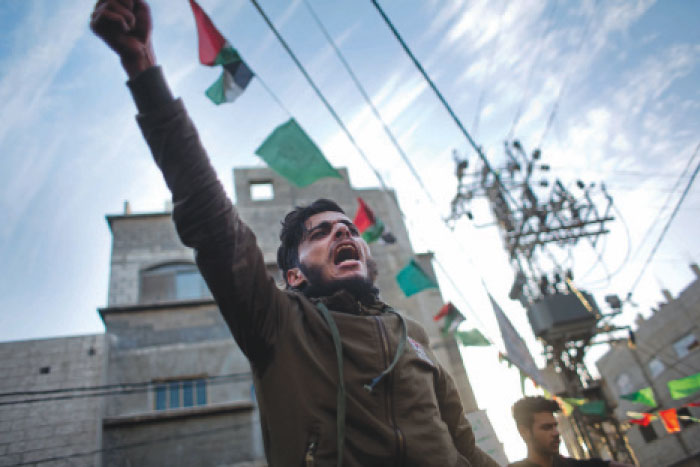
CRIPPLING shortages of electricity in the Gaza Strip and reports of children dying of cold have stoked anger in the Palestinian enclave where there are daily protests against Hamas leaders.
The main Palestinian factions are blaming each another and Israel for the crisis, which has left the territory with just four hours a day of power at best.
[caption id="attachment_112313" align="alignright" width="300"] Children play next to Gaza’s power plant in the town of Nusairat, central gaza Strip, Thursday. — AFP
Children play next to Gaza’s power plant in the town of Nusairat, central gaza Strip, Thursday. — AFP
[/caption]
In one of the largest demonstrations yet, thousands of protesters in northern Gaza on Thursday walked to the local headquarters of the electricity company run by Hamas, the Islamist movement that has ruled the Strip since 2007.
Security forces dispersed the protesters violently, with shots fired in the air and a number of journalists beaten up.
A prominent comedian was also detained on Wednesday after he posted on social media a call for Hamas to give up power.
UN envoy for the Middle East peace process Nickolay Mladenov expressed concern about the “tense situation” in Gaza and urged calm.
“We are witnessing a lot of anger and resentment at the power outages on the Gazan streets,” said Amjad Al-Shawwa, director of the Palestinian Non-Governmental Organizations Network.
Normally Gazans receive power in alternating eight-hour cycles, with those able to afford it having private fuel generators for the down times. But for two weeks they have received a maximum of four hours a day from the state energy supply.
Ahmad Al-Soarka believes the shortage is the reason he had to bury his 12-day-old son.
“My son died from frost and the extreme cold, according to what they told us in the hospital,” Soarka said.
The family’s home was destroyed in the 2014 war between Israel and Hamas and so they have lived in a caravan for two years. “Right now it is like a freezer,” the 24-year-old told AFP. “We have been here for two years.”
The health ministry has not confirmed the cause of death as yet, but Soarka’s father Salama, 49, said he had no doubt.
“If we had electricity we could protect ourselves and the children from the cold,” he said. “The young can’t tolerate it.”
More than two thirds of Gazans depend on aid, according to the United Nations, which has also estimated the enclave could become unlivable by 2020 if current trends continue.
The two million residents of Gaza require around 450-500 megawatts of power per day but are receiving less than half of that. With cold winters, demand has spiked — leading to the shortages.
Maher Al-Tabaa, an economic expert, said the crippling electricity shortages “affect all economic activities and have led to the suspension of a number of factories and economic construction.”
“The economy cannot manage only on electricity generators.”
Sadly for Gazans, there is no immediate solution to the crisis a decade in the making.
Israel has maintained a blockade of the enclave for 10 years, limiting goods and crippling the economy.
Israel argues such restrictions are necessary to contain Hamas, with which it has fought three wars since 2008.
But the more immediate cause of the crisis seems to be split between Hamas and the Palestinian Authority (PA), the internationally recognized Palestinian leadership which runs the West Bank.
Hamas seized control of Gaza from Fatah, which dominates the PA, in a near civil war in 2007.
The two factions have been unable to form a unity government and have been in dispute over tax bills on fuel imports.
In 2015 Gaza’s sole power plant, which itself was badly damaged in 2006 by Israel, shut down for several weeks over unpaid taxes.
Part of the reason energy authorities have so little funding is unpaid bills.
Nearly 70 percent of households do not pay their electricity bills, either through poverty or lack of collection, the UN estimates.
Fathi Sheikh Khalil, from Gaza’s electricity company, told AFP “what is available is distributed,” pointing to a shortage of funds.
Khalil Al-Hayya, a member of Hamas’s political bureau, said the party was willing to “hand over the electricity file” if a solution could be found, while the PA government in Ramallah notes it pays millions of dollars annually for Gazan electricity.
Celine Touboul, deputy director of the Economic Cooperation Foundation, an Israel-based think-tank, said it was a “recurrent” problem. She pointed out that Israel has finally authorized in principle in recent months increased electricity to Gaza via a new high voltage line but that without the Palestinian Authority’s support it was unlikely to materialize.
“The PA is generally reluctant to do anything practically that will benefit the Gaza Strip.” — AFP